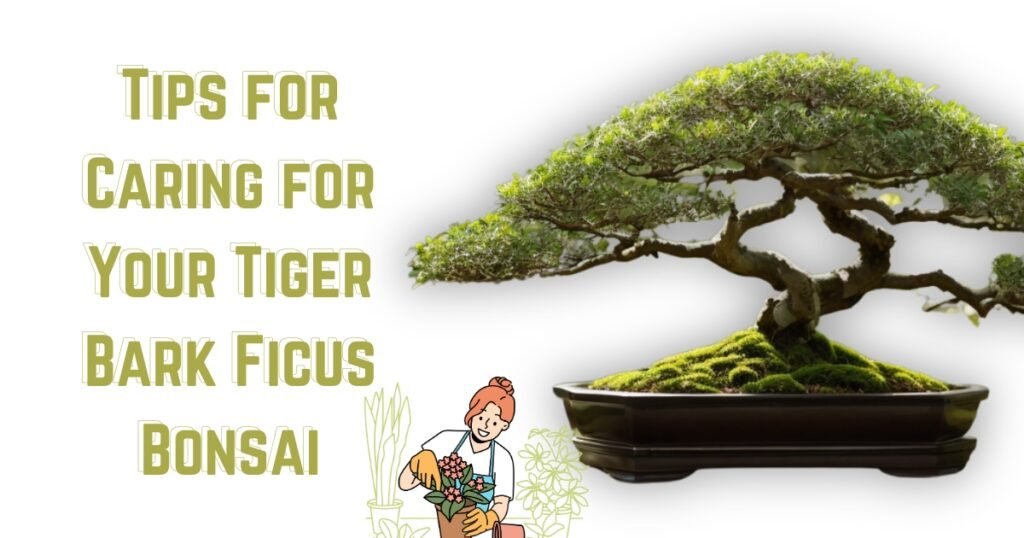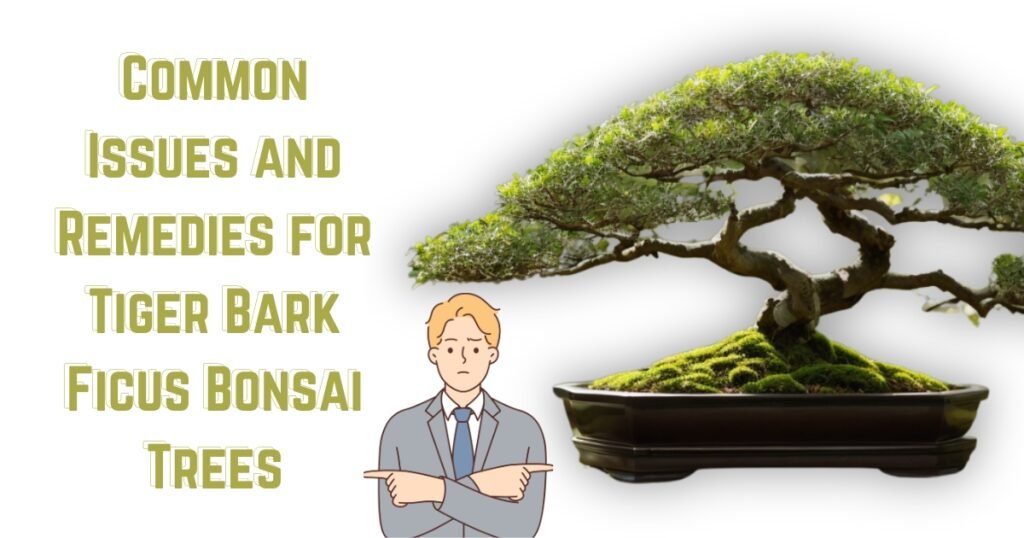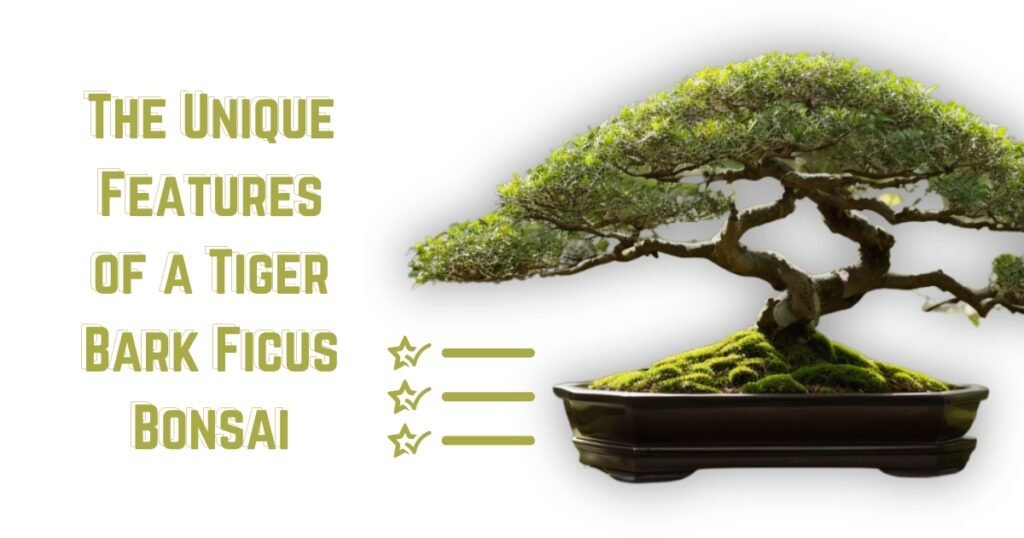Introduction
The Tiger Bark Ficus, also known as Ficus microcarpa ‘Kinmen’ or ‘Tigerbark’, is a bonsai favourite due to its stunning bark featuring a tiger-like pattern in shades of white.
The Tiger Bark Ficus has a distinct “tiger stripe” pattern on its bark that becomes more noticeable as the tree grows older.
This tree’s aerial roots can add a unique and exciting look to a bonsai. They thicken over time and can fuse with the trunk, creating impressive designs.
The Tiger Bark Ficus is an excellent choice for bonsai enthusiasts of all levels due to its versatility and forgiving nature.
Tips for Caring for Your Tiger Bark Ficus Bonsai
If you’re a proud Tiger Bark Ficus Bonsai owner, you should keep a few things in mind to ensure it stays healthy and happy. Let’s go through some critical aspects of caring for your little friend together, shall we?

Lighting
The bonsai tree needs bright, indirect light. It can survive in lower light but will have larger leaves and less dense foliage. Don’t expose it to direct sunlight, which can damage the leaves.
Watering
To keep the Tiger Bark Ficus healthy, water it when the top inch of soil is dry. Avoid overwatering as it can cause root rot.
Temperature
This tree needs warm temperatures and high humidity as it is a tropical species. It cannot tolerate frost and should be kept indoors if temperatures drop below 15 degrees Celsius.
Humidity
This tropical plant needs high humidity to thrive. Misting the leaves can boost humidity, particularly in dry indoor spaces.
Feeding
Feed your Tiger Bark Ficus from spring to autumn with a balanced bonsai fertilizer every two weeks. In winter, reduce feeding to once a month.
Pruning
To maintain the shape of the tree, it needs regular pruning. This species responds well to pruning and can be heavily pruned if required. Make sure to use sharp and clean tools while making cuts.
Repotting
Repot the tree every two years in spring with a bonsai soil mix to provide fresh nutrients and space for root growth.
Pest and Disease Control
Check your tree often for pests or diseases such as aphids, scale insects, and fungi. Treat as necessary.
Common Issues and Remedies for Tiger Bark Ficus Bonsai Trees
Common issues faced by Tiger Bark Ficus Bonsai trees include various problems that can affect their hardiness and resilience. Below are some common issues you might encounter and their corresponding remedies.

Leaf Drop: Ficus trees often experience leaf drop due to changes in light, temperature, or humidity levels or being repotted. Keep your tree in a stable environment with consistent light, temperature, and humidity. If the leaf drop persists, check if you’re over or under-watering.
Overwatering / Root Rot: Yellow or brown leaves falling off? Overwatering might be the issue. Check for soggy soil and reduce watering. Remove the affected roots and repot the tree if root rot is present.
Underwatering: Dry soil and wilting leaves indicate underwatering. Water more frequently to address the issue.
Pests: Ficus trees may get pests like aphids, mealybugs, scales, and spider mites. It might have pests if you see minor bugs, webbing, or a sticky substance on your tree. Use insecticidal soap or pesticide to treat the infestation.
Lack of Nutrients: Try using a balanced bonsai fertiliser for added nutrients to improve your tree’s growth and leaf colour.
Poor Light: To prevent large leaves and sparse foliage, move your tree to a brighter location. Avoid direct sunlight as it can scorch the leaves.
The Unique Features of a Tiger Bark Ficus Bonsai
The Tiger Bark Ficus Bonsai is a distinctive tree with several unique features.

- Tiger-Striped Bark: The Tiger Bark Ficus is named after its visually striking bark pattern resembling tiger stripes, making it a unique choice for bonsai.
- Aerial Roots: This bonsai species produces aerial roots that grow towards the soil. They create unique structures in high humidity, adding to the tree’s aesthetic appeal.
- Resilience: The Tiger Bark Ficus is a resilient and adaptable bonsai that can thrive in various light conditions. It’s easy to care for, making it an excellent choice for beginners and experienced enthusiasts.
- Versatility in Styling: The Ficus species is versatile and can be shaped into different bonsai styles, such as formal upright, slanting, semi-cascade, whole cascade, and group planting. It also responds well to wiring and pruning.
- Foliage: The Tiger Bark Ficus has small, glossy, and dark green leaves that form a dense canopy, making it an attractive bonsai.
- Fast-Growing: The Tiger Bark Ficus is an excellent choice for bonsai as it proliferates, resulting in noticeable changes and growth within a short period.
- Milky Sap: When pruned or damaged, the Ficus tree produces a milky sap.
Conclusion
The Tiger Bark Ficus Bonsai is an excellent plant for beginners and experienced enthusiasts. It can tolerate different conditions and proliferates. Proper care is essential, including lighting, watering, temperature, humidity, feeding, pruning, and repotting. Watch for leaf drop, overwatering, pests, nutrient deficiency, and light inadequacy. Monitor the plant closely and address any issues promptly. Be patient and let the tree grow and develop at its own pace.
Frequently Asked Questions (FAQs) about Tiger Bark Ficus Bonsai
What is a Tiger Bark Ficus Bonsai?
A Tiger Bark Ficus Bonsai is a popular bonsai tree known for its distinctive bark, rapid growth, and adaptability. It’s a great choice for both beginners and experienced bonsai enthusiasts.
How often should I water my Tiger Bark Ficus Bonsai?
Watering frequency depends on the climate and the tree’s environment. Generally, it would be best if you watered when the top soil feels dry to the touch. Overwatering or underwatering can harm the tree.
Where should I place my Tiger Bark Ficus Bonsai?
Tiger Bark Ficus Bonsai prefer bright, indirect sunlight. They can be grown indoors with enough light but thrive outside in warm climates.
How do I prune and shape my Tiger Bark Ficus Bonsai?
Pruning involves removing unwanted branches and leaves to control the tree’s shape. Wiring can be used to direct the growth of branches into desired positions.
Why are the leaves on my Tiger Bark Ficus Bonsai dropping?
Leaf drop can be a response to stress, such as a change in environment, overwatering, underwatering, or insufficient light.
Can I grow a Tiger Bark Ficus Bonsai from a cutting?
Yes, Tiger Bark Ficus trees can be propagated from cuttings. The cuttings should be planted in a well-draining soil mix and kept in a warm, humid environment.
How often should I fertilize my Tiger Bark Ficus Bonsai?
Generally, it’s recommended to fertilize every two weeks during the growing season and once a month during the winter. However, fertilizing frequency can depend on the specific nutrient needs of your tree.
Further Reading and Resources
- Mastering the Art of Bougainvillea Bonsai Tree Care: An Ultimate Guide
- The Vibrant World of Sumac Bonsai: A Comprehensive Guide
- Mastering the Art of Parsoni Juniper Bonsai: From Seedling to Showpiece
- Mastering the Art of Cultivating Bodhi Tree Bonsai (Ficus Religiosa): A Comprehensive
- The Charming Lemon Cypress Bonsai: A Comprehensive Guide
- The Exquisite Art of Growing Rainbow Eucalyptus Bonsai: A Comprehensive Guide





